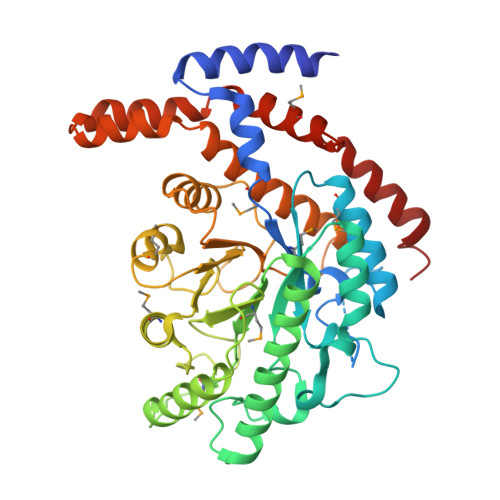The structure of rhamnose isomerase from Escherichia coli and its relation with xylose isomerase illustrates a change between inter and intra-subunit complementation during evolution.
Korndorfer, I.P., Fessner, W.D., Matthews, B.W.(2000) J Mol Biol 300: 917-933
- PubMed: 10891278
- DOI: https://doi.org/10.1006/jmbi.2000.3896
- Primary Citation of Related Structures:
1D8W, 1DE5, 1DE6 - PubMed Abstract:
Using a new expression construct, rhamnose isomerase from Escherichia coli was purified and crystallized. The crystal structure was solved by multiple isomorphous replacement and refined to a crystallographic residual of 17.4 % at 1.6 A resolution. Rhamnose isomerase is a tight tetramer of four (beta/alpha)(8)-barrels. A comparison with other known structures reveals that rhamnose isomerase is most similar to xylose isomerase. Alignment of the sequences of the two enzymes based on their structures reveals a hitherto undetected sequence identity of 13 %, suggesting that the two enzymes evolved from a common precursor. The structure and arrangement of the (beta/alpha)(8)-barrels of rhamnose isomerase are very similar to xylose isomerase. Each enzyme does, however, have additional alpha-helical domains, which are involved in tetramer association, and largely differ in structure. The structures of complexes of rhamnose isomerase with the inhibitor l-rhamnitol and the natural substrate l-rhamnose were determined and suggest that an extended loop, which is disordered in the native enzyme, becomes ordered on substrate binding, and may exclude bulk solvent during catalysis. Unlike xylose isomerase, this loop does not extend across a subunit interface but contributes to the active site of its own subunit. It illustrates how an interconversion between inter and intra-subunit complementation can occur during evolution. In the crystal structure (although not necessarily in vivo) rhamnose isomerase appears to bind Zn(2+) at a "structural" site. In the presence of substrate the enzyme also binds Mn(2+) at a nearby "catalytic" site. An array of hydrophobic residues, not present in xylose isomerase, is likely to be responsible for the recognition of l-rhamnose as a substrate. The available structural data suggest that a metal-mediated hydride-shift mechanism, which is generally favored for xylose isomerase, is also feasible for rhamnose isomerase.
Organizational Affiliation:
Institute of Molecular Biology Howard Hughes Medical Institute and Department of Physics, 1229 University of Oregon, Eugene, OR, 97403-1229, USA.
















